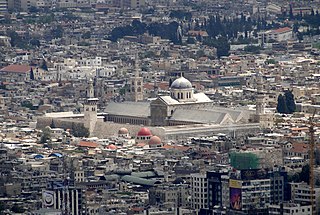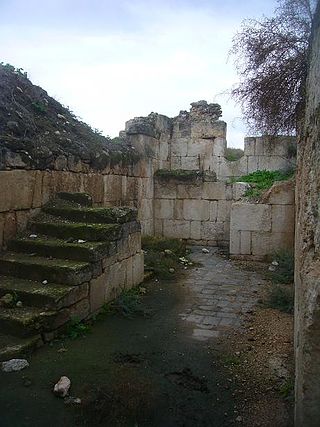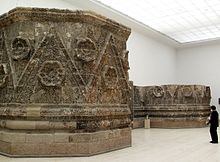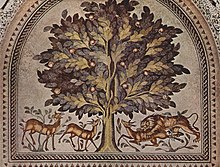
Islamic architecture comprises the architectural styles of buildings associated with Islam. It encompasses both secular and religious styles from the early history of Islam to the present day. The Islamic world encompasses a wide geographic area historically ranging from western Africa and Europe to eastern Asia. Certain commonalities are shared by Islamic architectural styles across all these regions, but over time different regions developed their own styles according to local materials and techniques, local dynasties and patrons, different regional centers of artistic production, and sometimes different religious affiliations.

Mihrab is a niche in the wall of a mosque that indicates the qibla, the direction of the Kaaba in Mecca towards which Muslims should face when praying. The wall in which a mihrab appears is thus the "qibla wall".

Qusayr 'Amra or Quseir Amra, lit. "small qasr of 'Amra", sometimes also named Qasr Amra, is the best-known of the desert castles located in present-day eastern Jordan. It was built some time between 723 and 743, by Walid Ibn Yazid, the future Umayyad caliph Walid II, whose dominance of the region was rising at the time. It is considered one of the most important examples of early Islamic art and architecture.

The Umayyad Mosque, also known as the Great Mosque of Damascus, located in the old city of Damascus, the capital of Syria, is one of the largest and oldest mosques in the world. Its religious importance stems from the eschatological reports concerning the mosque, and historic events associated with it. Christian and Muslim tradition alike consider it the burial place of John the Baptist's head, a tradition originating in the 6th century. Muslim tradition holds that the mosque will be the place Jesus will return before the End of Days. Two shrines inside the premises commemorate the Islamic prophet Muhammad's grandson Husayn ibn Ali, whose martyrdom is frequently compared to that of John the Baptist and Jesus.

Qal'at Bani Hammad, also known as Qal'a Bani Hammad or Qal'at of the Beni Hammad, is a fortified palatine city in Algeria. Now in ruins, in the 11th century, it served as the first capital of the Hammadid dynasty. It is in the Hodna Mountains northeast of M'Sila, at an elevation of 1,418 metres (4,652 ft), and receives abundant water from the surrounding mountains. The site is near the town of Maadid, about 225 kilometres (140 mi) southeast of Algiers, in the Maghreb.

Hisham's Palace, also known as Khirbat al-Mafjar, is an important early Islamic archaeological site in the Palestinian city of Jericho, in the West Bank. Built by the Umayyad dynasty in the first half of the 8th century, it is one of the so-called Umayyad desert castles. It is located 3 km north of Jericho's city center, in an area governed by the Palestinian National Authority (PNA).

The Mshatta Facade is the decorated part of the facade of the 8th-century Umayyad residential palace of Qasr Mshatta, one of the Desert Castles of Jordan, which is now installed in the south wing of the Pergamon Museum in Berlin, Germany. It is part of the permanent exhibition of the Pergamon Museum of Islamic Art dedicated to Islamic art from the 8th to the 19th centuries. This was only a relatively small section of the full length of the facade, surrounding the main entrance; most of the wall was undecorated and remains in situ.

Qasr Harrana, sometimes Qasr al-Kharana, Harana, Qasr al-Harrana, Qasr al-Haranah, Haraneh, Khauranee, or Hraneh, is one of the best-known of the desert castles located in present-day eastern Jordan, about 60 kilometres (37 mi) east of Amman and relatively close to the border with Saudi Arabia. It is uncertain when the palace was constructed, but it likely orginates from the Umayyad Dynasty. An inscription on an upper wall dates the building to before 710 CE. A Greek or Byzantine house may have existed on the site. The purpose of the building is a subject of debate among scholars. Theories as to the qasr's purpose include a Crusader's castle, a military stronghold, agricultural outpost, and resting place for caravan travelers. The current scholarly consensus is that the building was used as for meeting between local Bedouin leaders.
Oleg Grabar was a French-born art historian and archeologist, who spent most of his career in the United States, as a leading figure in the field of Islamic art and architecture in the Western academe.

Stucco decoration in Islamic architecture refers to carved or molded stucco and plaster. The terms "stucco" and "plaster" are used almost interchangeably in this context to denote most types of stucco or plaster decoration with slightly varying compositions. This decoration was mainly used to cover walls and surfaces and the main motifs were those predominant in Islamic art: geometric, arabesque, and calligraphic, as well as three-dimensional muqarnas. Plaster of gypsum composition was extremely important in Islamic architectural decoration as the relatively dry climate throughout much of the Islamic world made it easy to use this cheap and versatile material in a variety of spaces.
The Umayyad desert castles, of which the desert castles of Jordan represent a prominent part, are fortified palaces or castles in what was the then Umayyad province of Bilad al-Sham. Most Umayyad "desert castles" are scattered over the semi-arid regions of north-eastern Jordan, with several more in Syria, Israel and the West Bank (Palestine).

Jordanian art has a very ancient history. Some of the earliest figurines, found at Aïn Ghazal, near Amman, have been dated to the Neolithic period. A distinct Jordanian aesthetic in art and architecture emerged as part of a broader Islamic art tradition which flourished from the 7th-century. Traditional art and craft is vested in material culture including mosaics, ceramics, weaving, silver work, music, glass-blowing and calligraphy. The rise of colonialism in North Africa and the Middle East, led to a dilution of traditional aesthetics. In the early 20th-century, following the creation of the independent nation of Jordan, a contemporary Jordanian art movement emerged and began to search for a distinctly Jordanian art aesthetic that combined both tradition and contemporary art forms.

Qasr al-Hayr al-Sharqi is a castle (qasr) in the middle of the Syrian Desert. It was built by the Umayyad caliph Hisham ibn Abd al-Malik in 728-29 CE in an area rich in desert fauna. It was apparently used as a military and hunting outpost. The palace is the counterpart of Qasr al-Hayr al-Gharbi, a nearby castle palace built one year earlier. It is one of the so-called desert castles.

Qasr al-Hayr al-Gharbi is a Syrian desert castle or qasr located 80 km south-west of Palmyra on the Damascus road. The castle is a twin palace of Qasr al-Hayr al-Sharqi, built by the Umayyad caliph Hisham ibn Abd al-Malik in 727 CE. It was built in the Umayyad architectural style.

Khirbat al-Minya, also known as Ayn Minyat Hisham (Arabic) or Horvat Minnim (Hebrew) is an Umayyad-built palace in the eastern Galilee, Israel, located about 200 meters (660 ft) west of the northern end of Lake Tiberias. It was erected as a qasr complex, with a palace, mosque, and bath built by a single patron.

Qasr Mushatta is the ruin of an Umayyad winter palace, probably commissioned by Caliph Al-Walid II during his brief reign (743-744). The ruins are located approximately 30 km south of Amman, Jordan, north of Queen Alia International Airport, and are part of a string of castles, palaces and caravanserais known collectively in Jordan and the wider Southern Levant region as the Desert Castles. Though much of the ruins can still be found in situ, the most striking feature of the palace, its facade, has been removed and is on display at the Pergamon Museum in Berlin. The complex was never completed.

Hammam al-Sarah is an Umayyad bathhouse (hammam) in Jordan, built in connection with the complex of Qasr al-Hallabat, which stands some 2 kilometres (1.2 mi) to the west. Along with examples in the other desert castles of Jordan, it is one of the oldest surviving remains of a Muslim bathhouse.

Seljuk architecture comprises the building traditions that developed under the Seljuk dynasty, when it ruled most of the Middle East and Anatolia during the 11th to 13th centuries. The Great Seljuk Empire contributed significantly to the architecture of Iran and surrounding regions, introducing innovations such as the symmetrical four-iwan layout and the first widespread creation of state-sponsored madrasas. Their buildings were generally constructed in brick, with decoration created using brickwork, tiles, and carved stucco.

Ablaq is an architectural technique involving alternating or fluctuating rows of light and dark stone. It is an Arabic term describing a technique associated with Islamic architecture in the Arab world. It may have its origins in earlier Byzantine architecture in the region, where alternating layers of white stone and orange brick were used in construction.

Abbasid architecture developed in the Abbasid Caliphate between 750 and 1227, primarily in its heartland of Mesopotamia . The great changes of the Abbasid era can be characterized as at the same time political, geo-political and cultural. The Abbasid period starts with the destruction of the Umayyad ruling family and its replacement by the Abbasids, and the position of power is shifted to the Mesopotamian area. As a result there was a corresponding displacement of the influence of classical and Byzantine artistic and cultural standards in favor of local Mesopotamian models as well as Persian. The Abbasids evolved distinctive styles of their own, particularly in decoration. This occurred mainly during the period corresponding with their power and prosperity between 750 and 932.









































